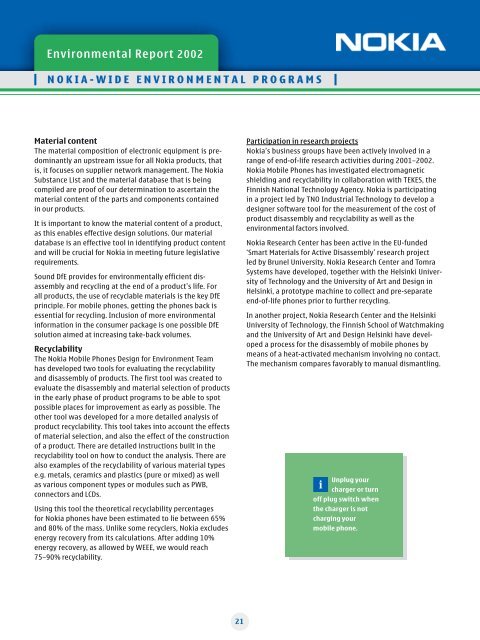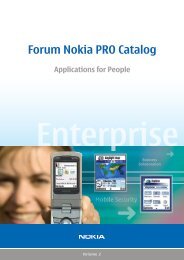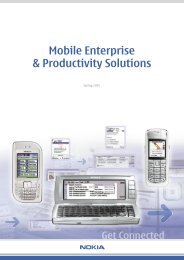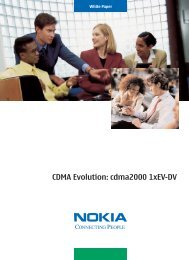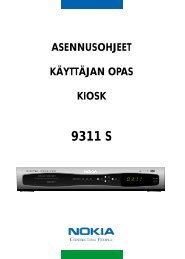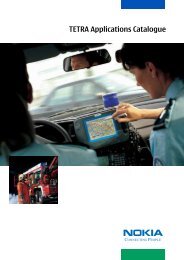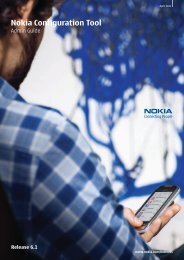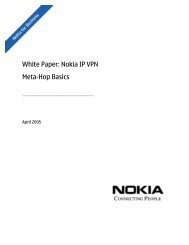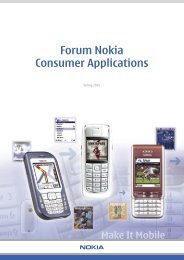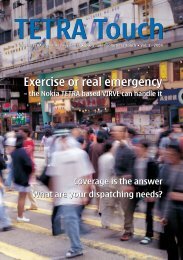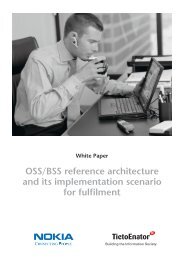Nokia Environmental Report 2002
Nokia Environmental Report 2002
Nokia Environmental Report 2002
Create successful ePaper yourself
Turn your PDF publications into a flip-book with our unique Google optimized e-Paper software.
<strong>Environmental</strong> <strong>Report</strong> <strong>2002</strong><br />
N O K I A - W I D E E N V I R O N M E N T A L P R O G R A M S<br />
Material content<br />
The material composition of electronic equipment is predominantly<br />
an upstream issue for all <strong>Nokia</strong> products, that<br />
is, it focuses on supplier network management. The <strong>Nokia</strong><br />
Substance List and the material database that is being<br />
compiled are proof of our determination to ascertain the<br />
material content of the parts and components contained<br />
in our products.<br />
It is important to know the material content of a product,<br />
as this enables effective design solutions. Our material<br />
database is an effective tool in identifying product content<br />
and will be crucial for <strong>Nokia</strong> in meeting future legislative<br />
requirements.<br />
Sound DfE provides for environmentally efficient dis-<br />
assembly and recycling at the end of a product’s life. For<br />
all products, the use of recyclable materials is the key DfE<br />
principle. For mobile phones, getting the phones back is<br />
essential for recycling. Inclusion of more environmental<br />
information in the consumer package is one possible DfE<br />
solution aimed at increasing take-back volumes.<br />
Recyclability<br />
The <strong>Nokia</strong> Mobile Phones Design for Environment Team<br />
has developed two tools for evaluating the recyclability<br />
and disassembly of products. The first tool was created to<br />
evaluate the disassembly and material selection of products<br />
in the early phase of product programs to be able to spot<br />
possible places for improvement as early as possible. The<br />
other tool was developed for a more detailed analysis of<br />
product recyclability. This tool takes into account the effects<br />
of material selection, and also the effect of the construction<br />
of a product. There are detailed instructions built in the<br />
recyclability tool on how to conduct the analysis. There are<br />
also examples of the recyclability of various material types<br />
e.g. metals, ceramics and plastics (pure or mixed) as well<br />
as various component types or modules such as PWB,<br />
connectors and LCDs.<br />
Using this tool the theoretical recyclability percentages<br />
for <strong>Nokia</strong> phones have been estimated to lie between 65%<br />
and 80% of the mass. Unlike some recyclers, <strong>Nokia</strong> excludes<br />
energy recovery from its calculations. After adding 10%<br />
energy recovery, as allowed by WEEE, we would reach<br />
75–90% recyclability.<br />
21<br />
Participation in research projects<br />
<strong>Nokia</strong>’s business groups have been actively involved in a<br />
range of end-of-life research activities during 2001–<strong>2002</strong>.<br />
<strong>Nokia</strong> Mobile Phones has investigated electromagnetic<br />
shielding and recyclability in collaboration with TEKES, the<br />
Finnish National Technology Agency. <strong>Nokia</strong> is participating<br />
in a project led by TNO Industrial Technology to develop a<br />
designer software tool for the measurement of the cost of<br />
product disassembly and recyclability as well as the<br />
environmental factors involved.<br />
<strong>Nokia</strong> Research Center has been active in the EU-funded<br />
‘Smart Materials for Active Disassembly’ research project<br />
led by Brunel University. <strong>Nokia</strong> Research Center and Tomra<br />
Systems have developed, together with the Helsinki University<br />
of Technology and the University of Art and Design in<br />
Helsinki, a prototype machine to collect and pre-separate<br />
end-of-life phones prior to further recycling.<br />
In another project, <strong>Nokia</strong> Research Center and the Helsinki<br />
University of Technology, the Finnish School of Watchmaking<br />
and the University of Art and Design Helsinki have developed<br />
a process for the disassembly of mobile phones by<br />
means of a heat-activated mechanism involving no contact.<br />
The mechanism compares favorably to manual dismantling.<br />
Unplug your<br />
charger or turn<br />
off plug switch when<br />
the charger is not<br />
charging your<br />
mobile phone.


